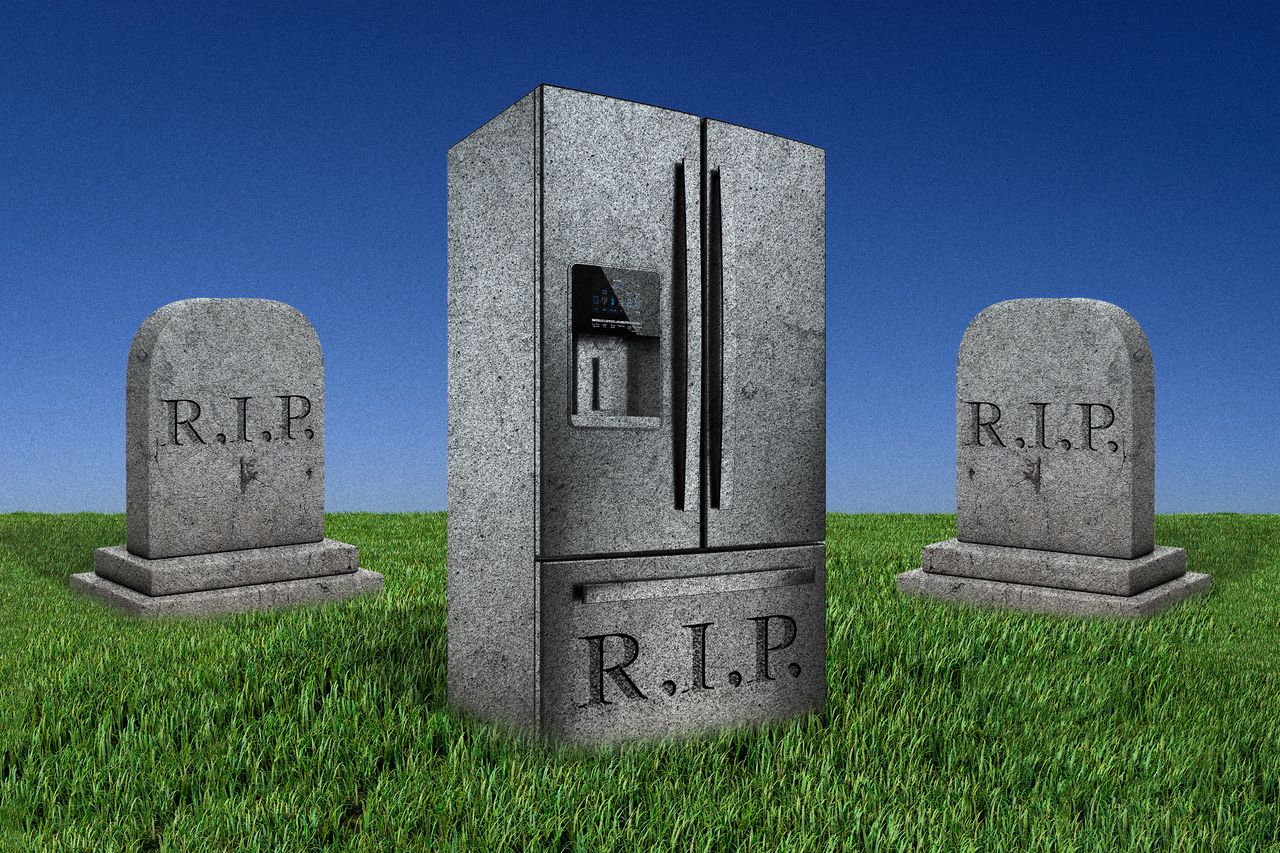The Lifespan of Large Appliances Is Shrinking
Appliance technicians blame a push toward computerisation and an increase in the quantity of components inside a machine
Our refrigerators, washing machines and ovens can do more than ever, from producing symmetrical ice cubes to remotely preheating on your commute home. The downside to all these snazzy features is that the appliances are more prone to breaking.
Appliance technicians and others in the industry say there has been an increase in items in need of repair. Yelp users, for example, requested 58% more quotes from thousands of appliance repair businesses last month than they did in January 2022.
Those in the industry blame a push toward computerisation, an increase in the quantity of individual components and flimsier materials for undercutting reliability. They say even higher-end items aren’t as durable.
American households spent 43% more on home appliances in 2023 than they did in 2013, rising from an inflation-adjusted average of $390 to $558, according to Euromonitor International. Prices for the category declined 12% from the beginning of 2013 through the end of 2023, according to the Labor Department.
One reason for the discrepancy between spending and prices is a higher rate of replacement, say consumers, repair technicians and others. That’s left some people wishing they had held on to their clunky ’90s-era appliances and others bargaining with repair workers over intractable ice makers and dryers that run cold.
“We’re making things more complicated, they’re harder to fix and more expensive to fix,” says Aaron Gianni, the founder of do-it-yourself home-repair app Plunjr.
Horror stories
Sharon J. Swan spent nearly $7,000 on a Bosch gas range and smart refrigerator. She thought the appliances would last at least through whenever she decided to sell her Alexandria, Va., home and impress would-be buyers.
That was before the oven caught fire the first time she tried the broiler, leading to a 911 call and hasty return. The ice-maker in the refrigerator, meanwhile, is now broken for the third time in under two years. Bosch covered the first two fridge fixes, but she says she’s on her own for the latest repair, totalling $250, plus parts.
“I feel like I wasted my money,” says the 65-year-old consultant for trade associations.
A Bosch spokeswoman said in an emailed statement that the company has been responsive to Swan’s concerns and will continue to work with her to resolve ongoing issues. “Bosch appliances are designed and manufactured to meet the highest quality standards, and they are built to last,” she said.
Kevin and Kellene Dinino wish they had held on to their white dishwasher from the ’90s that was still working great.
The sleeker $800 GE stainless steel interior dishwasher they purchased sprang a hidden leak within three years, causing more than $35,000 worth of damage to their San Diego kitchen.
Home insurance covered the claim, which included replacing the hardwood down to the subfloor and all their bottom cabinetry, but kicked the Dininos off their policy. The family also went without access to their kitchen for months.
“This was a $60 pump that was broken. What the hell happened?” says Kevin, 45, who runs a financial public-relations firm.
A GE Appliances spokeswoman said the company takes appliance issues seriously and works quickly to resolve them with consumers.
Increased complexity
Peel back the plastic on a modern refrigerator or washing machine and you’ll see a smattering of sensors and switches that its 10-year-old counterpart lacks. These extra components help ensure the appliance is using only the energy and water it needs for the job at hand, technicians say. With more parts, however, more tends to go wrong more quickly, they say.
Mansoor Soomro, a professor at Teesside University, a technical college in Middlesbrough, England, says home appliances are breaking down more often. He says that manufacturers used to rely mostly on straightforward mechanical parts (think an on/off switch that triggers a single lever). In the past decade or so, they’ve transitioned to relying more on sophisticated electrical and computerised parts (say, a touch screen that displays a dozen different sensor-controlled wash options).
When a complicated machine fails, technicians say they have a much harder time figuring out what went wrong. Even if the technician does diagnose the problem, consumers are often left with repairs that exceed half the cost of replacement, rendering the machine totalled.
“In the majority of cases, I would say buying a new one makes more economic sense than repairing it,” says Soomro, who spent seven years working at Siemens , including in the home-appliances division.
These machines are also now more likely to be made with plastic and aluminium rather than steel, Soomro says. High-efficiency motors and compressors, too, are likely to be lighter-duty, since they’re tasked with drawing less energy .
A spokeswoman for the Association for Home Appliance Manufacturers says the industry has “enhanced the safety, energy efficiency, capacity and performance of appliances while adding features and maintaining affordability and durability for purchasers.” She says data last updated in 2019 shows that the average life of an appliance has “not substantially shifted over the past two decades.”
When simpler is better
Kathryn Ryan and Kevin Sullivan needed a new sensor to fix their recently purchased $1,566 GE Unitized Spacemaker washer-dryer. GE wasn’t able to fix the sensor for months, so the couple paid a local technician $300 to get the machine working.
The repairman also offered them a suggestion: Avoid the sensor option and stick to timed dries.
“You should be able to use whatever function you please on a brand new appliance, ideally,” says Sullivan, a 32-year-old musician in Burbank, Calif.
More features might seem glamorous, Frontdoor virtual appliance tech Jim Zaccone says, but fewer is usually better.
“Consumers are wising up to the failures that are happening and going, ‘Do I really need my oven to preheat while I’m at the grocery store?’” jokes Zaccone, who has been in the appliance-repair business for 21 years.
He just replaced his own dishwasher and says he bought one with “the least bells and whistles.” He also opted for a mass-market brand with cheap and readily available parts. Most surprisingly, he chose a bottom-of-the-line model.
“Spending a lot of money on something doesn’t guarantee you more reliability,” says Zaccone.
 Copyright 2020, Dow Jones & Company, Inc. All Rights Reserved Worldwide. LEARN MORE
Copyright 2020, Dow Jones & Company, Inc. All Rights Reserved Worldwide. LEARN MORE
This stylish family home combines a classic palette and finishes with a flexible floorplan
Just 55 minutes from Sydney, make this your creative getaway located in the majestic Hawkesbury region.
Starting a new company with somebody requires a hard conversation. Better now than later.
You and a friend have a can’t-miss idea for a new business. You’ve got a great name, and the logo is perfect.
It is time to ask each other some hard questions.
Talking up front about tough subjects like how you work, how you deal with stress and your expectations for the business can save lots of headaches later. “Most issues are neutral when you discuss them ahead of time,” says Jane Brodsky , who ran a barre-and-spin studio with a partner for 10 years in Washington, D.C. “But in the heat of the moment, issues become personal and larger than they need to be.”
Here are crucial questions that should be settled at the start to help make the partnership succeed.
How did your family communicate?
Maybe you were raised in a family that talked through disagreements to find solutions. But maybe your partner grew up in a house where the loudest voice won. That could be a problem when issues arise in the business: Experts say that when people are under stress, they often fall back on behaviours that were imprinted at home—and different styles could clash.
At Happy Being, a company that sells nutritionally enhanced teas and drink powders, the three co-founders discussed communication style before they started the business. “We discovered that one partner gets triggered if he feels no one is listening,” says co-founder Dutch Buckley . “It goes back to an early fear of not being heard.” (For his part, co-founder Josemaria Silvestrini says that early on he “definitely needed the validation of being recognised and being right.”)
So, the three work at making sure everyone has a say in meetings, and they made a rule that no one’s work is ever belittled. On the flip side, when someone on the team accomplishes something, someone else on the team draws attention to it.
What does success look like to you? And failure?
While these may seem obvious—like, the business either succeeds or fails—everyone’s definition is different, and they are surprisingly specific. Certainly, monetary goals or anything that can be enumerated will help partners envision each other’s goals. Is one looking to grow slowly with customers and suppliers in the community and get to better than break even after three years, while the other wants to be cash-flow positive in year one and scale quickly to sell the business to a larger entity after 10 years? There’s a lot of success and failure in between those two outcomes, depending on your perspective.
Silvestrini of Happy Being recommends hashing it out together on the whiteboard until everyone agrees on an explicit definition of success for the company. “Hopefully, it’s an easy 10-minute conversation,” he says. “Because if founders have different objectives, the boat is going nowhere.”
What does everyone bring to the table?
It is crucial to discuss what each partner is contributing to the partnership in terms of expertise, experience, network and money. Kathryn Zambetti , an executive coach specialising in founder relationships, recommends taking an honest strengths-and-weaknesses inventory of yourself and your partner and then discussing what you both bring to the table. The exercise will help delineate which responsibilities naturally suit each partner, and it will highlight areas that will require additional work or outsourcing.
The clearer the roles can be defined, the better. If you are opening a bakery, you and your partner shouldn’t both be good at just making bread. Someone needs to handle marketing, suppliers, leases and licensing, financials and hiring and managing employees.
Why are you doing this?
You and your partner need to be in complete alignment on your motivations. Does this venture need to support your family or merely add to your vacation fund? Are you doing it to prove your father or your high-school econ teacher wrong? Any answer other than unfailing commitment to the mission or the product is a red flag.
“Your north star has to be something bigger than money to succeed,” says Buckley. “People will go through things that test them, but if money is the only motive, that won’t be enough.”
What pushes your buttons?
Just like in a marriage, you want to know best how to support and protect your business partner. Understanding what puts each of you in a fight-or-flight mode can be key to getting the best out of each other.
Do you need to be consulted on all decisions, or just major ones? Do you need to be recognized as the leader and sit at the head of the table? Do you fear having to downsize your home if the business fails?
What does your workday look like?
Does a day at the office mean working 9 to 5? Can the work be done remotely and on your own time? If you work well at night and need rapid responses to questions, is it a problem having a partner whose phone goes on “do not disturb” every evening at 7? Having the conversation and understanding expectations is key.
When Buckley started Happy Being, the team learned that one of the partners got up very early. “I had to tell him, ‘We don’t want 6 a.m. calls.’ ”
Do you like taking gambles?
A penchant for lottery tickets, Las Vegas gambling or high-adrenaline activities like skydiving shows a potential partner’s tolerance for risk and whether that aligns with your own. There will be countless decisions early on in a business concerning risk, and the partners need to be on the same page.
So ask about it. You go into the venture planning and hoping for success, but how much money or time is your partner willing to lose if it doesn’t succeed? How much of their parents’ or in-laws’ money would they bet on the partnership?
Is the business more important than the friendship?
Many business partners start as friends. But would you each be willing to give priority to making the right decision for the business, even if it means possibly hurting the friendship? Would you each be capable of letting the other one go if it was better for the company? Most advisers recommend choosing a partner who has a common business goal and letting the friendship build from that, rather than trying to build a partnership on top of a strong friendship.
“Your business partner will be one of your most intense relationships, but it shouldn’t fulfill every role in your life,” says Amy Jurkowitz, entrepreneur and co-founder of branding adviser Bread Ventures. “You need to be compatible in how much energy you will both put into the business.”
If the partnership doesn’t work out, how will it end?
A co-founder relationship is a binding agreement with financial and emotional repercussions, just like a marriage. But starting a business has the added stress of having the company—the baby—arrive on day one. If there is a divorce, who gets custody?
The more specific you can be about potential breakups, the better. If you are both putting capital in at the start, would you expect to get that out if you exited? What if, several years in, one partner can’t continue to struggle without a regular paycheck and leaves—and the next year the company finally turns a profit or is bought by another company? Would the partner who left get a share of the money?
These discussions should help make it clear that the survival of the company—and not the partnership or the friendship—is the ultimate goal. Those who have been through a business breakup recommend involving a third party to help sort through these issues at the outset.
This stylish family home combines a classic palette and finishes with a flexible floorplan
Just 55 minutes from Sydney, make this your creative getaway located in the majestic Hawkesbury region.






















